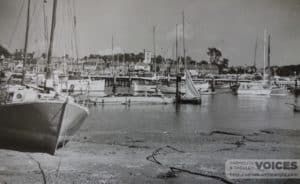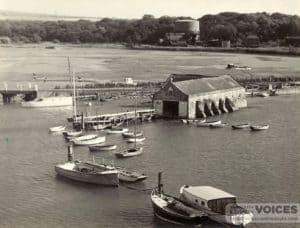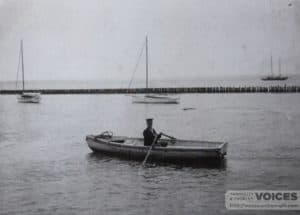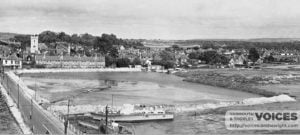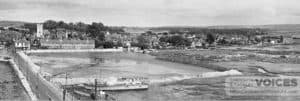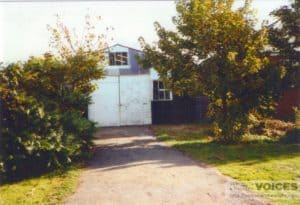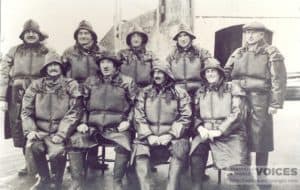Wally Feaver had this,- about, what?- fifty foot type motor cruiser and he’d say to us lads, “Can you come and give us a hand, nipper? We want to do the underside of the boat – anti fouling.’ We laid on the mud, absolutely covered in stuff. Cor, what a job! Because there were these huge great bilge keels on it, and you had to slide up in between them. Les Turner b1944
Category Archives: Uncategorized
Nick Chandler: Harbour 1960s, 1970s
We did have a real shocker; the Doctor, Doctor Brydon. He was such a shocker that when the Smith’s boatbuilding business was going, they kept a stock of bow sprits for him . He was always smashing his bow sprit up. I can’t remember the name of the boat, lost in the mists of time, she would have been somewhere in the 3 to 5 tonner size. He sailed her single handed.
When Charlie was working, if he saw Dr Brydon under full sail coming in, he would guide him straight on to the mud bank, so as he came to a stop. He would then be safely manoeuvred on to a mooring.
Harold Hayles went with him to Cowes one day, why I don’t know, but anyway Dr Brydon said to Harold, ‘I have a lobster on board. We’ll have that going to Cowes,’
so off they went with lobster on the boil. When the lobster was done, the water was tipped out of the pot and in the bottom of the pot were two spark plugs.
Harold said, ‘What are they for?’
‘Oh, I ‘m boiling them clean,’ said the Doctor, ‘They’ll do no harm, and I thought I would cook the lobster at the same time.’
The last I ever heard of Doctor Brydon was when I was working at Fort Vic. Nelson and I were sent down to inspect some damage to one of our boats (RASC). The Doctor had sailed into the harbour and driven his bowsprit straight through one of our boats, through a port hole, through the toilet door trapping someone in the toilet.
It was definitely an army boat, it was either the Foil or the Erme. I remember going to the store to draw a new port hole. You could draw a new port hole, but ask for sheet of glass paper and you were asking for the world. Nick Chandler b 1937
Nick Chandler: Harbour, River Yar boatyard, 1950s, 1960s
One day I saw the Thames Barge moored up to the bank over Gas Works. I thought, I must have a look at that, so I went over there, stood on the quay looking at it. The old Admiral popped up, ‘Hello. Can I help you?’
‘Just interested. Having a look,’
‘Come aboard!’ so on I went. We were talking and I told him I was a boatbuilder.
He said, ‘Just the chap I’m looking for! There’s lot of work needs to be done on this barge.’
I thought, I’m not a barge builder. This is different; great spikes and dumps. He said would I go and work for him, so I was shared between him and Stan Smith for a bit.
I never did go to sea with Admiral Larkin on the barge. He was asking me but we never got round to it. When the barge was under way it seemed to me it was,‘ Full ahead and trust in the Lord,’ sort of thing. In the winter of ‘63 she was froze in solid up there for weeks. The ice was thick enough to walk down the creek to the river.
Some friends of the Admiral’s came down from London with their Atlanta which they wanted painting up, so I said,
‘I can build a little dock over there,’ which I did, and that was the first job in what became River Yar Boatyard. Yes, it all went well, until the old Admiral shot himself.
The new management and me did not get on, until one day I demanded my cards and walked off, went back next day and collected my toolbox.
I saw Barry McDonald that day and he told me they wanted someone down here (the Harbour).
‘Go and see Major Sheppard,’ which I did, got the job in 1966 and was there for 30 odd years. Nick Chandler
Billy Doe: Harbour Master 1950s
Billy Doe, Harbour Master
The big effort was when they used to go across to Lymington, seagull egging. When there was a marsh over there, there used to be trillions of the things, black headed gulls, and they used to sell them as plovers’ eggs – that’s what they called them. The Harbour Master when I was small, was Billy Doe. When he retired the Harbour Commissioners gave him a launch, about eighteen foot.
The Commissioners gave that to Billy so he didn’t have to row across to go egging, because he used to go across egging as well. The launch had a little Lister diesel.
The season of the year to collect seagulls eggs was about April on.
I can remember going across with grandfather. All the marsh was separated by little streams and the old fellows all had their own little bit; they used to bang a stake in with their name on. They all had some agreement with all the old fellows from around there and the first thing they did – the first day you went over – was to break all the eggs.
You broke all the eggs you could see, and went back a couple of days later and they’d pretty much be fresh. Alec Cokes b 1945
Pauline and Jack Harwood: Harbour, houseboat,1950s
When we got married we couldn’t afford to buy a house. We were lucky because a sleeping sickness specialist chap in Kenya or somewhere – Robin Cox and his wife – he went back, and he said we could have their houseboat.
It was nice, plenty of room. We had a nice little stove, and one night Jack built up the stove so it got so hot we thought it would catch fire.
We wondered why there were so many mugs around and pots. When it rained we realised; rain came in everywhere.
When the tide was wrong and the wind came from the south, she used to come up on her end but we never came adrift from the mooring/gangway. We were on ‘Bluenose’, but it started off as ‘Spinwham’ – same boat.
Stan Smith lived on it for a bit and then Colonel Mitchell. And then Penny and her husband and it ended up at the top of the river. Pauline Harwood nee Hatch b 1935
Jean Maitland: Harbour breakwater construction, 1930s
Bob Cook’s grandfather, Bob Buckett, and Jack Payne, Fred Wadham and my Dad, Bill Levey, they put in all the piles for the harbour breakwater by hand. You wouldn’t have had a pier or breakwater if it wasn’t for them. You can see their piling rig in the photo, the crab winch in the background was part of it. See the length of pipe in his hand?
They would push it on the winch brake handle so you could hold the brake on – the handles on them were never long enough. Winching that weight up time and time again, to knock the piles in, that was hard work wasn’t it eh? The times they went in the tide under the pier when they were rebuilding it! Look at the clothes they wore in those days, didn’t have overalls and if it rained they got wet. My Dad fell in, sea boots and all. Good job he was a good swimmer.
I can always remember how the old men used to get down the Spit and Lean on the Quay, spinning yarns. You know how these old boys like to yarn.
Jean Maitland nee Levey
Brian Pomroy: Harbour, Smith’s boatshed 1940s
Colin Smith: Harbour, Theo Osborne Smith’s boatyard 1930s
Father had the boatyard that, at that time, came straight on to the water when the tide was up. There was a lot of sedge and so on, but there was a channel along the
first of all, and up to the back of the Institute, the Liberal Club I believe they called it in those days. Just beyond, the stream ran along to what was the Dump, the beginning of where they used to bring the lorries in and dump off rubbish. Now they’ve covered the whole lot of course.
My grandfather started the yard there as I understand it. Grandfather’s name was Theo Osborne Smith. He used to have the name on the sign. His first shed was an old ex army canteen. He bought it and had it re-erected there, and there was another little arched type of building behind as well. He originally started up at Oxford on the Upper Thames and then moved down, first to Fawley, over at Ashlett Creek. He had a little business there, and then for some reason, I haven’t got a clue why, moved over to Yarmouth. He specialised in mostly little centre-board type of sailing boats, twenty foot or twenty two thereabouts and so on. He built one of them, the ‘Menomopote’ it was called, Child of the Ocean. I don’t know where they got that name from. A very unusual boat, very easy underwater shape and the top sides were paired off and came round into a kind of chine and at midship it came right up to the gunwale (or gunnel) . He was a very advanced designer. I don’t think my father took it to the same extent. Colin Smith b 1921
Eileen Smith: Harbour, Storm 1930s
There was that September, a terrific gale. There was water over the Quay and almost up to the Square. Boats in the harbour were sending out distress calls and drifting their moorings. It was so rough, Walt Cotton wouldn’t let them launch the boarding boat to go across. There was water over Bridge Road so they floated her round, put her over the rails. Three men went out with ropes attached and brought the Lifeboat alongside.
There was one man drowned that night, in the harbour. That was a night!
Eileen Smith nee Lansdowne b 1921
Revd. Stanley Woodin leading the procession, followed by Robert May, verger and undertaker. Lifeboat crew members Charlie Lansdowne front right in cap, Walter Cotton cox following
Eileen Smith, Charlie Lansdowne: Harbour, Lifeboat, 1920, 1930s
My father was signalman on the lifeboat – there was no radio, they had to rely on signals, semaphore and morse. His boots were kept just inside the door so if the maroon went he could be gone straight away. On one occasion when the lifeboat went out, I can remember my mother asking Mrs Cotton, the Coxswain’s wife where they’d gone, but they never knew, of course, when they’d be back. Walter Cotton, the Coxswain had come from Brighstone. My father said if Walter was moved, he’d go with him, he was such a good coxswain. Eileen Smith b 1921
Back row from left: Harry White, Jim Hobbs, Charlie Lansdowne,( signalman) Harold Hayles. Capt. Cottrell,
Front row: Fred Wadham, Albert Hayward( engineer) , Walter Cotton ( coxswain), Stan Smith (2nd cox)

